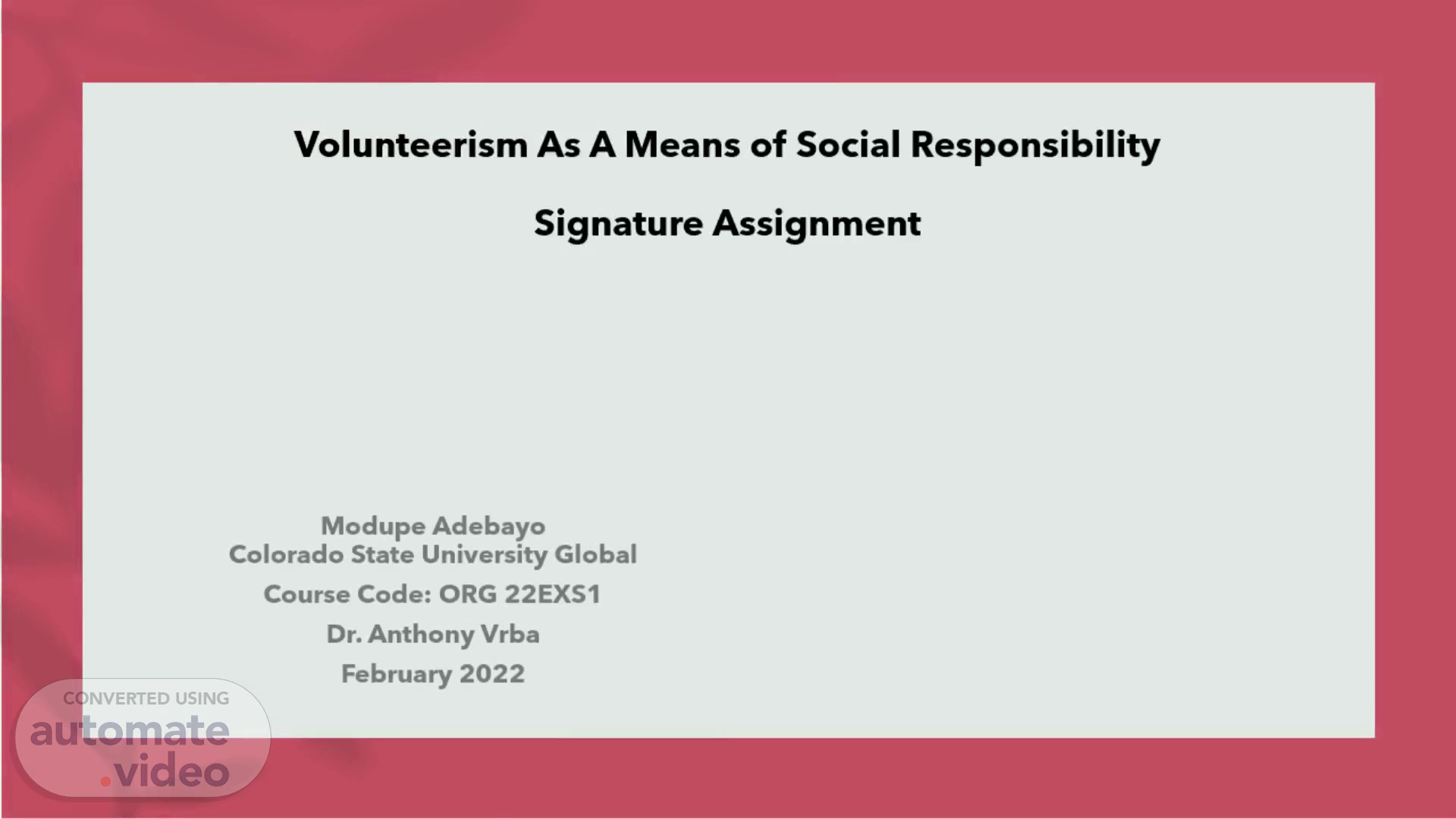
Volunteerism As A Means of Social Responsibility Signature Assignment
Scene 1 (0s)
Volunteerism As A Means of Social Responsibility Signature Assignment.
Scene 2 (12s)
AGENDA. Volunteering Experience [Red Cross and United Nations Social and Recreation Club (UNSRC) Nigeria Association] Key Elements of a Non-Profit Non-Profit and Ethical Considerations Cultural Competence and Diversity Leadership and Mentoring Volunteerism For Social Change Volunteering Opportunities in Organizations Expand Your Network Conclusion References.
Scene 3 (1m 1s)
Volunteering Experience with UNSRC and Red Cross.
Scene 4 (3m 7s)
Key Elements of Non-Profit. Tax exempt, incorporated or unincorporated non-business entity that do not declare profit. Benefits the mission of the organization, interest of the public and its members (e.g. The American Red Cross). Serves purpose of members (e.g. UNSRC Nigeria Association).
Scene 5 (3m 38s)
Volunteering in Non-Profits. Non-profits struggle to recruit volunteers; positions usually offer no monetary compensation or career opportunities. Volunteers help non-profits by providing personnel capabilities, including with dispersing, and spreading news about the mission and vision of the organization ( Febriani , and Selamet , 2020).
Scene 6 (4m 27s)
Non-Profit and Ethical Considerations. Non-profits need to be trustworthy so that they can be trusted to succeed. Main purpose is to make “social profit”. Ensure cost-efficient way of using resources for social objectives as defined by the organization ( BouOrtmann and Schlesinger, 2003)..
Scene 7 (5m 11s)
Cultural Competence and Diversity. Cultural competence means an awareness of one’s own existence, sensations, thoughts, and environment without letting it have an undue influence on those from other backgrounds (Purnell and Paulanka , 2008). Board member diversity and expertise are associated with better‐ performing organizations (Harris, 2014)..
Scene 8 (6m 7s)
Leadership and Mentoring. Good leaders cast a vision for their community or organization ( Goossen and Stevens, 2013). A mentor helps a protégé learn something that he or she would have learned less well, more slowly, or not at all if left alone (Bell, 2000)..
Scene 9 (7m 10s)
Volunteerism For Social Change. V olunteering is about giving back and can have benefits both for individuals and the society. V olunteering is a key part of any Corporate Social Responsibility (CSR) strategy and can bring numerous benefits both to employees and companies and organizations themselves..
Scene 10 (8m 0s)
Volunteering Opportunities in Organizations. Support for employee’s interests outside of the workplace environment can enhance employee engagement. Helps with a holistic expression of individual values and leads to active engagement in organizations..
Scene 11 (8m 38s)
Expand Your Network. Networking is a process of building relationships. Expand your network or lose opportunities!.
Scene 12 (9m 7s)
Conclusion. Engagements outside one’s network is important. Volunteering is one way to contribute to society, build relationships, and make connections, to expand and improve one’s outreach..
Scene 13 (9m 29s)
References. Bell, C. R. (2000). The mentor as partner. Training and Development , 54(2), 52 Bouckaert , L. & Vandenhove , Jan. (1998). Business Ethics and the Management of Non-Profit Institutions. Journal of Business Ethics, 17 (9/10), 1073–1081. Farrell, M. (2019). Leadership Reflections: Who Are Your Peeps? (Links to an external site.) Journal of Library Administration, 59 (4), 422–430. https://doi.org/10.1080/01930826.2019.1593714 Febriani , D. M., & Selamet , J. (2020). College Students’ Intention to Volunteer for Non-profit Organizations: Does Brand Image Make a Difference? Journal of Non-profit & Public Sector Marketing, 32 (2), 166–188. https://doi.org/10.1080/10495142.2019.1656136 Goossen , R. J. & Stevens, P. R (2013). Entrepreneurial Leadership: Finding Your Calling, Making a Difference. IVP Books. Harris, E. E. (2014). The impact of board diversity and expertise on nonprofit performance. Nonprofit Management and Leadership, 25 (2), 113-130. doi:10.1002/nml.21115 Katmon , N., Mohamad, Z. Z., Norwani , N. M., & Farooque , O. A. (2019). Comprehensive Board Diversity and Quality of Corporate Social Responsibility Disclosure: Evidence from an Emerging Market. J ournal of Business Ethics, 157 (2), 447–481. https://doiorg.stanford.idm.oclc.org/10.1007/s10551-017-3672-6 Purnell L & Paulanka B (2008) Transcultural Health Care: A Culturally Competent Approach. 3rd ed. Philadelphia, PA: F.A. Davis Company..
Scene 14 (9m 36s)
Thank You For Your Attention.. Smiling Face with No Fill.